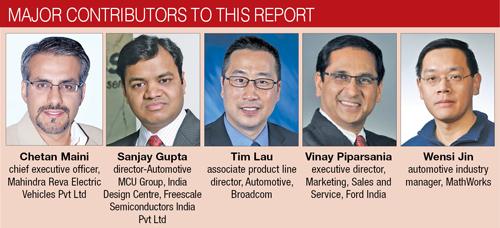Likewise, a recent report by IHS Automotive shows that Linux is growing to be the preferred automotive infotainment platform. Models of Buick, GMC, Chevrolet and Opel use or will soon be using Linux. The report states that other car makers such as BMW, PSA and Jaguar/Land Rover are also committed to using a version of Linux that is compatible with the GENIVI platform.
More updates.
- BMW’s iRemote App allows users to access vehicle information and control features from their mobile device and smart watch.
- Mercedes-Benz also recently showed how owners can use a smart watch to remotely unlock doors, check fuel levels, plan the car’s trip or blow the horn.
- GM demonstrated its App Shop at CES 2014, providing the means for Chevrolet owners to download and install GM-approved apps right into their cars’ dashboards.
- Audi’s next-gen cars will feature an in-built Android tablet, the 26cm (10.2-inch) Audi Smart Display. Powered by an NVIDIA Tegra 4 chip, the tab is extremely rugged with notably high resistance to temperature and physical damage. It uses the in-car Wi-Fi to provide Web access for entertainment, navigation and remote vehicle control.
- Mahindra e2o, the new electric car in India, has remote heating, ventilation, air-conditioning system (HVAC) activation via smartphone, a first in India. It also features telematics-based remote diagnostics, a first in India, and one of only four cars in the world and a best-in-class touch-screen-based infotainment unit with navigation, CAN bus integration, iPod integration, Bluetooth and EV status information.
My car, my silicon
Understandably, a smart car is packed with a myriad of electronics that implement everything from drive safety and engine management to car security and infotainment. This means big opportunity for the semiconductor industry.
“Semiconductor growth in the automotive market will be very significant. We are seeing a lot of growth, not just infotainment and ADAS, but also in powertrain, body control and safety electronics. All of those markets will see significant growth. There are a lot of different sectors that will be able to take a leading role in this market. Semiconductor providers who offer microcontrollers, communications technology and sensor technologies—all of those will take a leading role. At the same time, we believe that the Tier-1’s, the resellers, developers, partners, all of them will take a leading role because the connected car ecosystem is going to require a lot more support in terms of software development, application development, hardware engineering, wiring suppliers, cabling suppliers, who will take a leadership role to help take that technology forward,” says Lau.

The auto industry consumes microcontrollers, microprocessors, analogue ICs, discrete electronics, logic circuits, sensors and memory for electronic control systems. The current trend is to use field-programmable gate arrays (FPGAs) and system-on-chip (SoC) or system-on-module (SoM) solutions that combine several components into one small form factor.
Freescale, NXP Semiconductors, Bosch, Infineon, ST Microelectronics and Renesas are amongst some of the key suppliers to the auto industry, offering a horde of solutions for sensing, in-vehicle networking, automotive lighting, car radio and audio to automotive power and telematics on-board units to access and immobilisation. Most of these companies also offer associated design tools.
More updates.
- Nvidia announced the Tegra K1 processor at CES 2014. With 192 cores, it claims to be the hardware that can fully enable the future autonomous car. Audi will be using the K1 chip in production cars in the near future.
- Bosch offers single-chip airbag system ICs that combine power supply, sensor interfaces, I/O functions, firing loop drivers and safing engine on one single chip. The semiconductor industry offers several SoCs, such as angular rate sensors for vehicle dynamics control (VDC), and combined inertial sensors for VDC and active suspension.
- The intensive developments in ADAS and infotainment have led to far greater semiconductor requirements, which the semiconductor world is quickly gearing up to meet. Freescale, for example, offers the i.MX6 family, which provides up to four high-performance ARM Cortex-A9 cores, advanced graphics and video accelerators for processing of up to five 1-megapixel video streams at 30 fps for surround view part assist system.
My car, my pal
Most people love their car like it is their family member. So, would they not like to communicate with their car using more natural communication techniques such as speech or gestures? This is nice, not only from a personalisation aspect, but also from the perspective of safety.
SYNC, an in-car voice-interactive technology featured by Ford helps drivers to pay attention to the road without having to use their hands for making phone calls, browse phone contacts, read texts and browse music. “It helps keep things simple and safe, while on the move,” says Piparsania.










